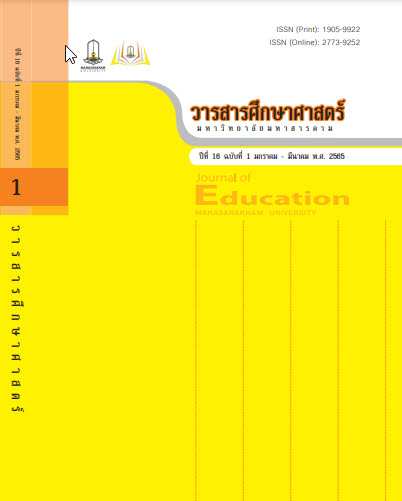Development of the Design Thinking-based Learning Approach on the Design Thinking Approach to Promote Creativity and Innovation of Vocational Students about Nutrition in Daily Life
Main Article Content
Abstract
This research aimed to 1) study the design thinking-based learning approach to promote creativity and innovation about nutrition in daily life and 2) study vocational students’ creativity and innovation through 4 spiral cycles of action research. The participants were 32 second-year students studying for vocational Education Certificate at a Vocational Institute in
Chainat province by purposive sampling. The research instruments consist of lesson plans, reflective journals, observation protocols, and student artifacts. Data were analyzed by content analysis and were verified using method triangulation.
The results showed that 1) the design thinking-based learning approach had five steps:1) empathy, 2) define, 3) ideate, 4) prototype, and 5) test. The application of the approach must be aware of choosing a problem situation that relates to the student’s daily life and using questions to connect the conditions and contents of nutrition. This helped students to
be able to analyze, develop and create a real piece of work concerned their future careers. Also, 2) most of the students had developed their creativity and innovation. In descending order, they achieved a high level of creative production and innovation, self-reflection, creative collaboration with others, design and customize ideas, and creating ideas.
Downloads
Article Details

This work is licensed under a Creative Commons Attribution-NonCommercial-NoDerivatives 4.0 International License.
References
จรูญพงษ์ ชลสินธุ์. (2561). การวิจัยปฏิบัติการเพื่อพัฒนาการจัดการเรียนรู้ เรื่อง ปริมาณสารสัมพันธ์ตามแนวสะเต็มศึกษาที่เน้นกระบวนการออกแบบเชิงวิศวกรรม ที่ส่งเสริมสมรรถนะการแก้ปัญหาแบบร่วมมือ. วารสารศึกษาศาสตร์ มหาวิทยาลัยนเรศวร, 20(2), 32-46.
ณพัฐอร บัวฉุน นฤมล ยุตาคม และพจนารถ สุวรรณรุจิ. (2559). สภาพการจัดการเรียนการสอนรายวิชาวิทยาศาสตร์เพื่อคุณภาพชีวิต หมวดวิชาศึกษาทั่วไป. วารสารวิจัยและพัฒนา วไลยอลงกรณ์ในพระบรมราชูปถัมภ์, 11(2), 97-106.
พงษ์ชัย ศรีพันธุ์. (2546). วิทยาศาสตร์ประถมศึกษา. การศึกษาวิทยาศาสตร์คณิตศาสตร์และ เทคโนโลยี, 31(121), 8-9.
ภัสสร ติดมา. (2558). การจัดการเรียนรู้ตามแนวทาง STEM Education เรื่องระบบของร่างกายมนุษย์เพื่อส่งเสริมความคิดสร้างสรรค์ สำ หรับนักเรียนชั้นมัธยมศึกษาปีที่ 2. วารสารราชพฤกษ์, 13(3), 71-76.
วันเพ็ญ คำ เทศ. (2558). การใช้คำ ถามในการจัดการเรียนรู้ (5E Model of Instruction). นิตยสารสสวท., 43(196), 26-30.
วันเพ็ญ นันทะศรี. (2560). การพัฒนาทักษะความคิดสร้างสรรค์ของนักศึกษาด้วยการเขียนแผนที่ความคิด. วารสารบัณฑิตศึกษา, 14(64), 43-50.
วิจารณ์ พานิช. (2555). วิถีการสร้างความรู้เพื่อศิษย์ในศตวรรษที่ 21. กรุงเทพฯ: ตถาตาพับลิเคชั่น.
ศศิธารา พิชัยชาญณรงค์. (2554). ยุทธศาสตร์ “2555” กระทรวงศึกษาธิการด้านการอาชีวศึกษา. สืบค้น 18 สิงหาคม 2563, จาก http://www.vec.go.th/Portals/0/Doc/vecit.pdf
สุธิดา การีมี. (2560). การใช้กระบวนการออกแบบเชิงวิศวกรรมเพื่อเสริมสร้างความคิดสร้างสรรค์ และทักษะการแก้ปัญหา. สืบค้น 18 สิงหาคม 2563, จาก http://oho.ipst.ac.th/edp-creativeproblem-solving1/
BBC News. (2019). PISA results show that Thai students’ reading is getting worse. Retrieved March 14, 2020, from https://www.bbc.com/thai/international-50642536
Brophy, S. P., Stacy, K., Merredith, P., & Chris, R. (2008). Advancing Engineering Educationin P-12 Classrooms. Retrieved July 26, 2020, from https://online library.wiley.com/doi/abs/10.1002/j
Catalina Foothills School District ; CFSD. (2018). CREATIVITY-INNOVATION. Retrieved July 28, 2020, from https://www.cfsd16.org/application/files/4715/2989/28 59/K12_CREATIVITY-INNOVATION_2018.pdf
Choueiri, L. S., & Mhanna, S. (2013). The design process as a life skill. Procedia-Social and Behavioral Sciences, 93, 925-929.
Johansson, S. U., Woodilla, J., & Cetinkaya Sendas, M. (2013). Design thinking: Past, present and possible futures. Creativity and Innovation Management, 22(2), 121-146.
Kemmis, S & McTaggart, R. (1988). The action research planner. (3rd ed.). Victoria: Deakin University.
Mela, A. (2018). An analysis of a teacher’s questioning related to students’ responses and mathematical creativity in an elementary school in the UK. International Electronic Journal of Elementary Education, 10(4), 475-487.
Morgan, C. (2013). STEM project-based learning: An integrated science, Technology, Engineering, and Mathematics (STEM) Approach. Retrieved August 18, 2020, from https://researchoutput.csu.edu.au/en/publications/stem-project-based-learning-an-integrated-science-technology-engineering
The Stanford d. school Boot camp Bootleg. (2010). Design thinking bootleg. Retrieved August 18, 2020, from https://static1.squarespace.com/static//METHODCARDS-v3-slim.pdf
Wen-Haw, C. (2013). Applying problem-based learning model and creative design to conicsection teaching. Retrieved August 18, 2020, from http://www.naun. org/main/NAUN/educationinfromation/c012008-099.pdf
Yee, F.P. (2002). Using short open-ended mathematics questions to promote thinking and understanding. Retrieved August 18, 2020, from http://math. unipa.it/grim/SiFoong


